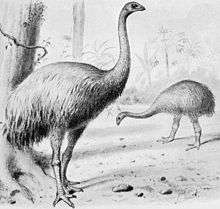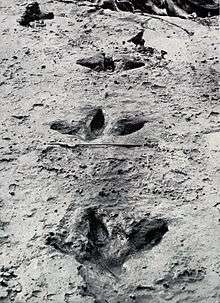South Island giant moa
| South Island giant moa | |
|---|---|
 | |
| Skeleton | |
| Scientific classification | |
| Kingdom: | Animalia |
| Phylum: | Chordata |
| Class: | Aves |
| Superorder: | Paleognathae |
| Order: | Dinornithiformes |
| Family: | Dinornithidae |
| Genus: | Dinornis |
| Species: | D. robustus (Owen, 1846) Bunce et al. 2003[1] |
| Binomial name | |
| Dinornis robustus (Owen, 1846) | |
| Synonyms | |
|
List
| |
The South Island giant moa (Dinornis robustus) is a member of the moa family. It was a ratite and a member of the order Dinornithiformes. The Dinornithiformes are flightless birds with a sternum without a keel. They also have a distinctive palate. The origin of these birds is becoming clearer as it is now believed that early ancestors of these birds were able to fly and flew to the southern areas in which they have been found.[2]
The South Island giant moa was the biggest of them all. Adult females stood up to 2 metres (6 ft 6 in) high at the back, and could reach foliage up to 3.6 metres (11 ft 10 in) off the ground, making them the tallest bird species known. (Found on Szabo, M.J. 2013. South Island giant moa. In Miskelly, C.M. (ed.) New Zealand Birds Online. www.nzbirdsonline.org.nz) [2]


It lived on the South Island of New Zealand, and its habitat was the lowlands (shrubland, duneland, grassland, and forests).[2]
Footnotes
- ↑ Checklist Committee Ornithological Society of New Zealand (2010). "Checklist-of-Birds of New Zealand, Norfolk and Macquarie Islands and the Ross Dependency Antarctica" (PDF). Te Papa Press. Retrieved 4 January 2016.
- 1 2 3 Davies, S. J. J. F. (2003)
References
- Brands, Sheila (Aug 14, 2008). "Systema Naturae 2000 / Classification, Genus Dinornis". Project: The Taxonomicon. Retrieved Feb 4, 2009.
- Davies, S.J.J.F. (2003). "Moas". In Hutchins, Michael. Grzimek's Animal Life Encyclopedia. 8 Birds I Tinamous and Ratites to Hoatzins (2 ed.). Farmington Hills, MI: Gale Group. pp. 95–98. ISBN 0-7876-5784-0.
Szabo, M.J. 2013. South Island giant moa. In Miskelly, C.M. (ed.) New Zealand Birds Online. www.nzbirdsonline.org.nz
External links
- South Island Giant Moa. Dinornis robustus. by Paul Martinson. Artwork produced for the book Extinct Birds of New Zealand, by Alan Tennyson, Te Papa Press, Wellington, 2006
